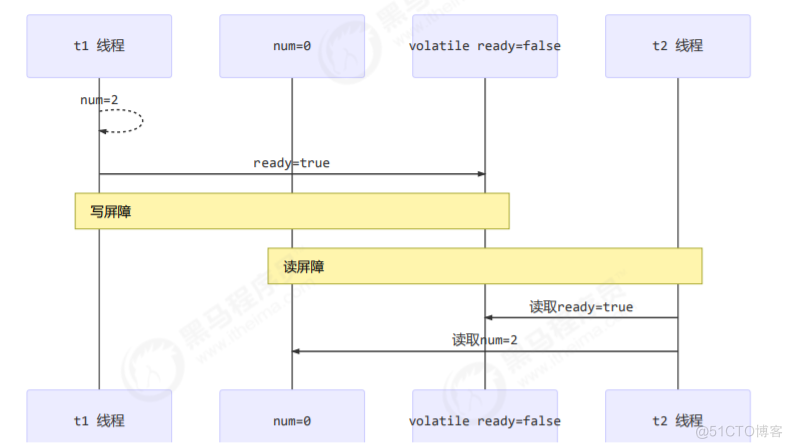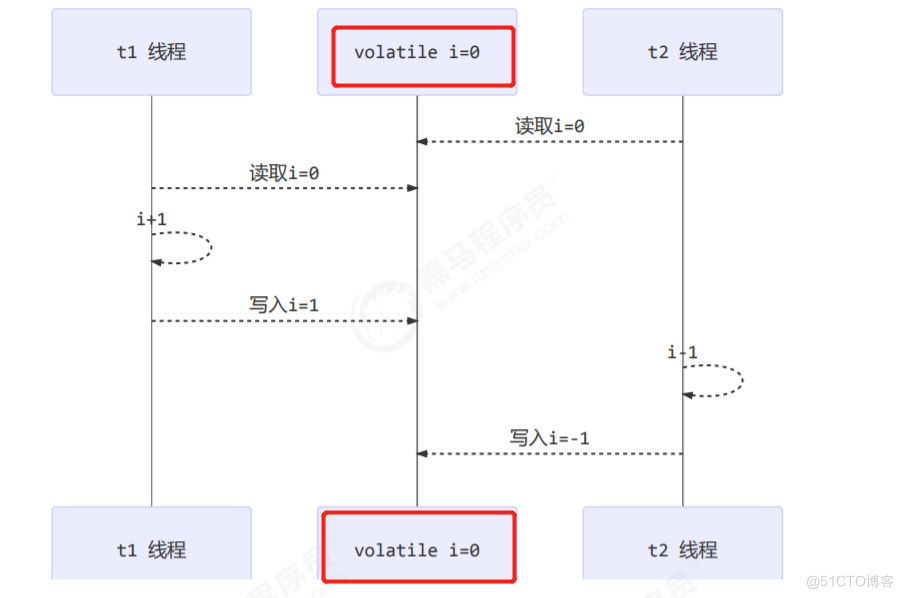一、volatile 原理
线程频繁对主内存读写操作,会产生性能问题,因此线程都有一个自己的工作内存。读写操作都会在工作内存中执行,而不会到主内存中。
volatile 的底层实现原理是内存屏障:
- 对 volatile 变量的写指令后会加入写屏障
- 对 volatile 变量的读指令前会加入读屏障
1.1 保证可见性
写屏障(sfence)保证在该屏障之前的,对共享变量的改动,都同步到主存当中
public void actor2(I_Result r) {num = 2;
ready = true; // ready是被volatile修饰的 ,赋值带写屏障
// 写屏障
}
而读屏障(lfence)保证在该屏障之后,对共享变量的读取,加载的是主存中最新数据
1. public void actor1(I_Result r) {// 读屏障
// ready是被volatile修饰的 ,读取值带读屏障
if(ready) {
r.r1 = num + num;
} else {
r.r1 = 1;
}
}

1.2保证有序性
- 写屏障会确保指令重排序时,不会将写屏障之前的代码排在写屏障之后
num = 2;
ready = true; // ready是被volatile修饰的 , 赋值带写屏障
// 写屏障
}
- 读屏障会确保指令重排序时,不会将读屏障之后的代码排在读屏障之前 x 1public void actor1(I_Result r) {2// 读屏障3// ready是被volatile修饰的 ,读取值带读屏障4if(ready) {5r.r1 = num + num;6} else {7r.r1 = 1;8}9}
- 而有序性的保证也只是保证了本线程内相关代码不被重排序
一句话:volatile 能保证可见性和有序性,但无法保证原子性。monitor则可以同时保证这三个

1. 首次使用 getInstance() 才使用 synchronized 加锁,后续使用时无需加锁
2. 有隐含的,但很关键的一点:第一个 if 使用了 INSTANCE 变量,是在同步块之外
但在多线程环境下,上面的代码是有问题的,getInstance 方法对应的字节码为: ```
0: getstatic #2 // Field INSTANCE:Lcn/itcast/n5/Singleton;
3: ifnonnull 37
// ldc是获得类对象
6: ldc #3 // class cn/itcast/n5/Singleton
// 复制操作数栈栈顶的值放入栈顶, 将类对象的引用地址复制了一份
8: dup
// 操作数栈栈顶的值弹出,即将对象的引用地址存到局部变量表中
// 将类对象的引用地址存储了一份,是为了将来解锁用
9: astore_0
10: monitorenter
11: getstatic #2 // Field INSTANCE:Lcn/itcast/n5/Singleton;
14: ifnonnull 27
// 新建一个实例
17: new #3 // class cn/itcast/n5/Singleton
// 复制了一个实例的引用
20: dup
// 通过这个复制的引用调用它的构造方法
21: invokespecial #4 // Method <init>:()V
// 最开始的这个引用用来进行赋值操作
24: putstatic #2 // Field INSTANCE:Lcn/itcast/n5/Singleton;
27: aload_0
28: monitorexit
29: goto 37
32: astore_1
33: aload_0
34: monitorexit
35: aload_1
36: athrow
37: getstatic #2 // Field INSTANCE:Lcn/itcast/n5/Singleton;
40: areturn
1.3 happens-before规则
下面说的变量都是指成员变量或静态成员变量
1)线程解锁 m 之前对变量的写,对于接下来对 m 加锁的其它线程对该变量的读可见
static int x;
static Object m = new Object();
new Thread(()->{
synchronized(m) {
x = 10;
}
},t1).start();
new Thread(()->{
synchronized(m) {
System.out.println(x);
}
},t2).start();
2)线程对 volatile 变量的写,对接下来其它线程对该变量的读可见
volatile static int x;
new Thread(()->{
x = 10;
},t1).start();
new Thread(()->{
System.out.println(x);
},t2).start();
3)线程 start 前对变量的写,对该线程开始后对该变量的读可见
static int x;
x = 10;
new Thread(()->{
System.out.println(x);
},t2).start();
4)线程结束前对变量的写,对其它线程得知它结束后的读可见(比如其它线程调用 t1.isAlive() 或 t1.join()等待它结束)static int x;
Thread t1 = new Thread(()->{
x = 10;
},t1);
t1.start();
t1.join();
System.out.println(x);
5)线程 t1 打断 t2(interrupt)前对变量的写,对于其他线程得知 t2 被打断后对变量的读可见(通过 t2.interrupted 或 t2.isInterrupted)static int x;
public static void main(String[] args) {
Thread t2 = new Thread(()->{
while(true) {
if(Thread.currentThread().isInterrupted()) {
System.out.println(x);
break;
}
}
},t2);
t2.start();
new Thread(()->{
sleep(1);
x = 10;
t2.interrupt();
},t1).start();
while(!t2.isInterrupted()) {
Thread.yield();
}
System.out.println(x);
}
6)对变量默认值(0,false,null)的写,对其它线程对该变量的读可见
7)具有传递性,如果 x hb-> y 并且 y hb-> z 那么有 x hb-> z ,配合 volatile 的防指令重排,有下面的例子volatile static int x;
static int y;
new Thread(()->{
y = 10;
x = 20;
},t1).start();
new Thread(()->{
// x=20 对 t2 可见, 同时 y=10 也对 t2 可见
System.out.println(x);
},t2).start();
